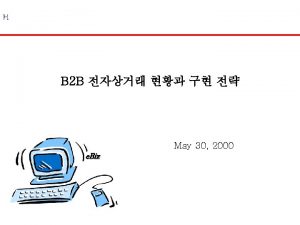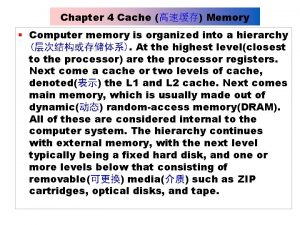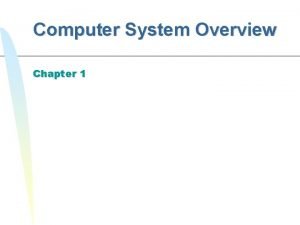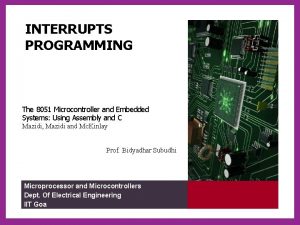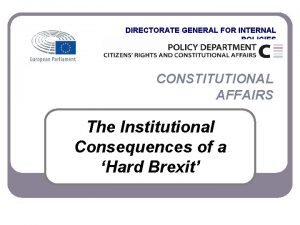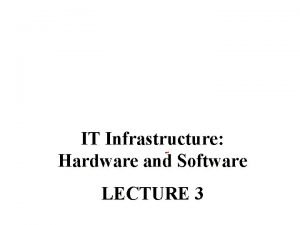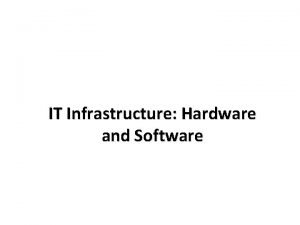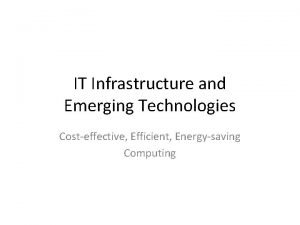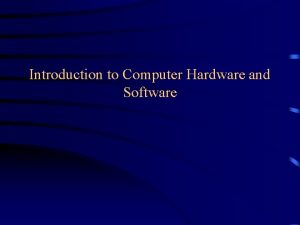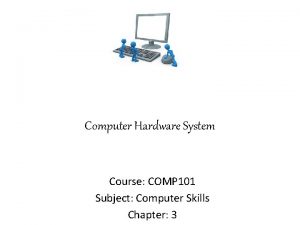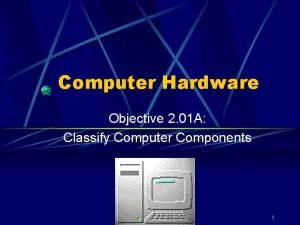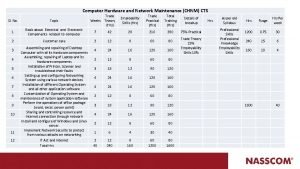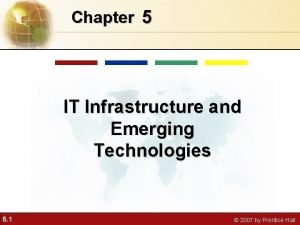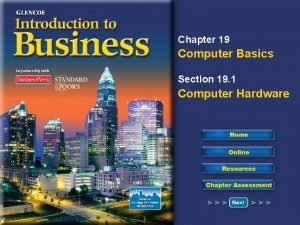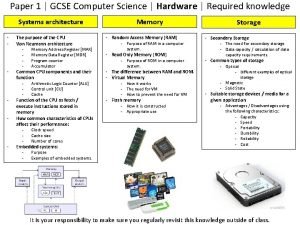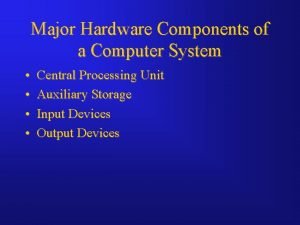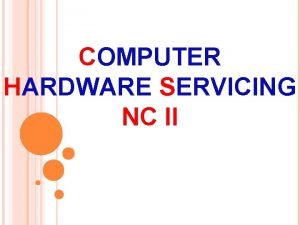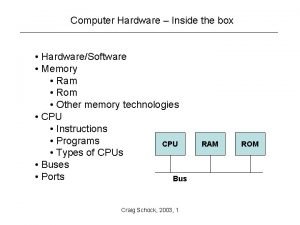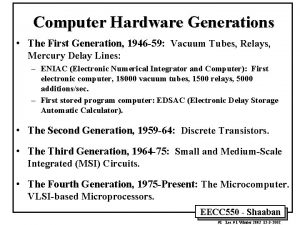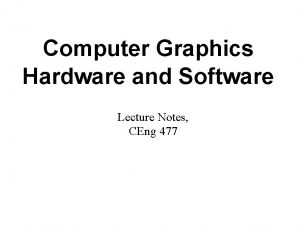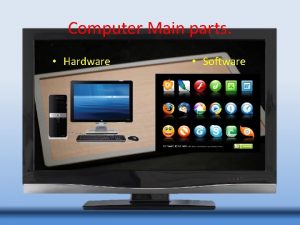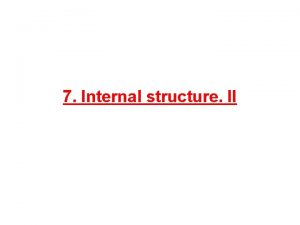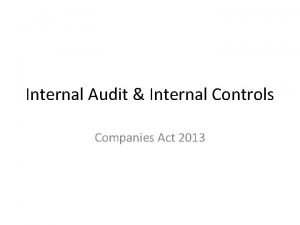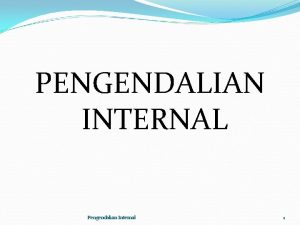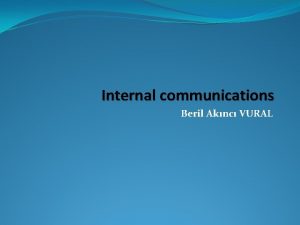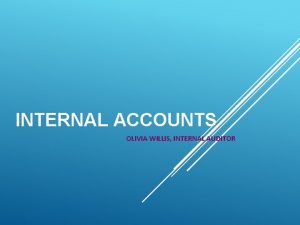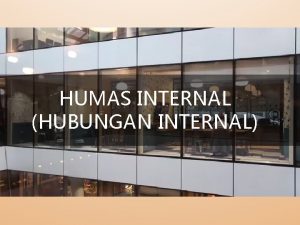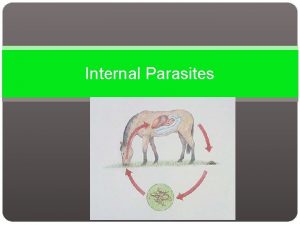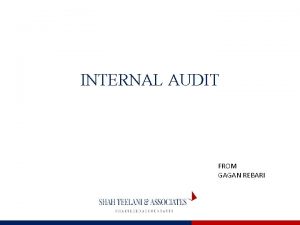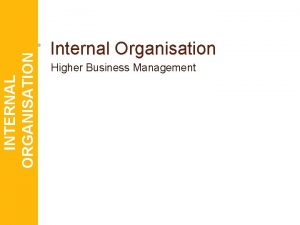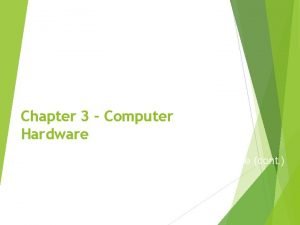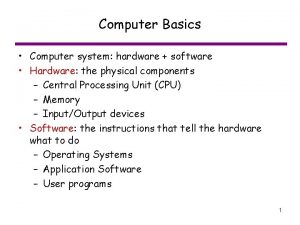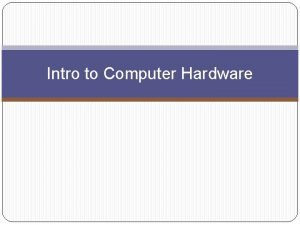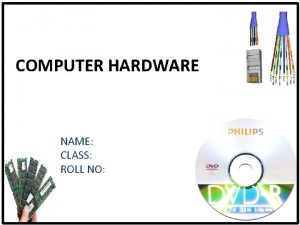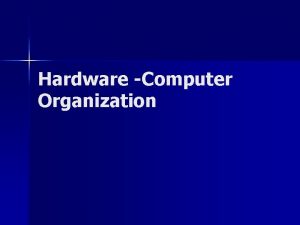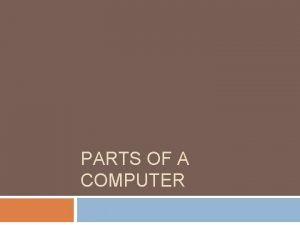Computer Hardware General Overview Hardware The internal structure





































































- Slides: 69

Computer Hardware General Overview Hardware: The internal structure of computers, how they operate and how they are used in solving problems.

Programming -is about Software…why do we have to learn about Hardware and other stuff? psychiatrist Doctor of the…………. ?

From the OCR Specification ¡ AS Unit F 451: Computer Fundamentals 3. 1. 1 Components of a Computer System Types of hardware Types of software Candidates should be able to: ¡ define the terms hardware, software, input device, storage device and output device; ¡ describe the purpose of input devices, storage devices and output devices; ¡ describe the different roles and functions of systems software and applications packages.

What is a Computer System? What is it comprise of? How would you define it?

Robots = Computer Systems?

How are computer systems different from a -HUMAN? Human Beings: Body (Flesh) Soul (Mind, Emotions etc) Spirit (Spiritual)

HUMANS AND ANIMALS… What is the difference? Mind (intuitive) Survival Instinct Body Do Animals Have the capacity to be spiritual? Complex Choices?

Computer Systems ¡ ¡ Hardware Software Hardware=The physical components (electrical circuits) that make up the computer Software=The computer programs (sequences of instructions) that tell the computer what to do in response to a command or some event.

How do we communicate with computers? What does this symbol Mean?

Language called BINARY

The only thing a computer understands is ¡ 1 ¡ 0

Components of a Computer The program currently being executed is stored here. (it is divided into storage units called BYTES) For reading data into Main Memory MAIN MEMORY INPUT DEVICES For processing the data Fix The Mistakes PROCESSOR AUXILIARY STORAGE For printing, displaying Or out-put of info For permanent storage of programs and data OUTPUT DEVICES

Components of a Computer The program currently being executed is stored here. (it is divided into storage units called BYTES) For processing the data MAIN MEMORY INPUT DEVICES For reading data into Main Memory PROCESSOR For printing, displaying Or out-put of info OUTPUT DEVICES AUXILIARY STORAGE For permanent storage of programs and data

Think of the Brain (System) Information for the Exam…. ¡ INPUT ¡ PROCESSING ¡ OUTPUT Exam Results!

Computer Systems are the same Data is INPUT ¡ Data is PROCESSED ¡ Something is OUTPUT ¡ ¡ GIGO (Garbage in…Garbage out. . )

Types of Computer Minicomputers ¡ Mainframe Computers ¡ Supercomputers ¡

Minicomputers Multi-user systems ¡ 100’s of workstations or terminals attached to central minicomputer ¡ E. g. EPOS (Electronic Point of Sale) Systems ¡

Mainframe computers Large Organisations –banks, building societies, airlines, governments ¡ May have 1000’s of terminals – geographically remote locations ¡ Could occupy a whole site ¡ 100’s of disk drives & hardware units ¡ Location often kept secret! (terrorist attacks) ¡

Supercomputers Largest Category of computer ¡ Cost Millions ¡ Mostly used by scientific and industrial research departments ¡ NASA –government agencies ¡ Weather Centres ¡ Stock Exchanges ¡ Large Commercial Organisations ¡

PC, Mini, Mainframe or Supercomputer?

PC, Mini, Mainframe or Supercomputer?

NASA Goddard Space Centre ¡ ¡ Fourth Largest Supercomputer in the world Linux Operating System Huge Memory Processing Power – unparalleled!

PC, Mini, Mainframe or Supercomputer?

PC, Mini, Mainframe or Supercomputer?

Dr. Mark Seager of Lawrence Livermore National Laboratory inspects the world's fastest _________a 64 -rack Blue Gene complex. From picasaweb. google. com/. . . /Ky. Pj. Mr. Kht. XMLpv. Ik. Z 4 Jhtw

The processor PROCESSES! ¡ Faster the processor, better the PC? ¡

What is the equivalent (in humans) to the processor? How does the Brain process? -receives an instruction (stimulus) -decodes & produces an appropriate instruction -executes the instruction! -slap on the cheek –anger/revenge etc logged -anger decoded –instruction to slap back -slap back! (OR TURN THE OTHER CHEEK? )

Processor Brain of the computer ¡ Processes instructions THREE STEPS 1) Fetches Instructions 2) Decodes Instruction 3) Executes Instruction ¡

What is a Processor? ¡ ¡ Most computers use integrated chips…. or integrated circuits for their processors or main memory A chip is about 1 cm square…and can hold MILLIONS of electronic components such as transistors and resistors CPU of a microcomputer is a microprocessor Processor and MAIN MEMORY of a PC are held on a single board called a motherboard.

PROCESSORS ¡ ¡ Either chips or integrated circuits Integrated circuits are also found in almost every modern electrical device such as cars, television sets, CD players, cellular phones, etc.

CHIP An electric circuit is made from different electrical components such as transistors, resistors, capacitors and diodes, that are connected to each other in different ways. These components have different behaviors. The transistor acts like a switch Resistor –resists electricity –so you can control current Capacitor –controls electricity Diode –also allows control of current and flow A computer chip is an electronic circuit (consisting mainly of semiconductor devices, as well as passive components) that has been manufactured in the surface of a thin substrate of semiconductor material.

Why Integrated Circuits (transistors)? Before –there were VACUUM TUBE ¡ They were huge –costly –bulky – easily burned out ¡ The first Computer –ENIAC –huge 30 ton monster! *use of 18000 or so vacuum tubes* ¡

Types of Processors INTEL

A hybrid integrated circuit is a miniaturized electronic circuit constructed of individual semiconductor devices, as well as passive components, bonded to a substrate or circuit board. Jack Kilby's Integrated circuit, the first working Integrated circuit created

New Super-Efficient Chip Could Run on Body Heat

MAIN MEMORY ¡ ¡ ¡ The program currently being executed and the data used by the program is held in MAIN MEMORY MM is divided into millions of individually addressable storage units called BYTES One byte can hold one character Or one byte can hold a code representing something –i. e a part of a picture, or a sound, or a program instruction. The total number of bytes in MM = The computers MEMORY SIZE.

Computer Memory Sizes 1 KB (KB) =1024 Bytes ¡ 1 MB =1024 KB ¡ 1 GB =1024 MB ¡ 1 Tb =1024 GB (about 1 trillion bytes) ¡

Main Memory Processing power and Main Memory in a computer has increased exponentially in the past year! It has grown at a rate that no one could have predicted. ¡ 1980 –Microcomputers with 32 K of memory were bought for thousands of homes and schools! ¡

Bill Gates made the famous remark… ¡ “ 640 K ought to be enough for anybody. . ” 1981…. Things have changed drastically! 2004 –PC with 512 MB of MM was standard….

Today?

Watch this (hilarious!) Notice how excited they were on unveiling this machine… ¡ http: //www. youtube. com/watch? v= z. J 12 v. NZ 5 y. MY *also notice how the audience CLAPS when the floppy Disk is taken out of his pocket! (in those days the thought Of storage that could be moved around was revolutionary!)

RAM and ROM There are two kinds of Memory ¡ RAM –Random Access Memory (MM) (this is used for storing programs that are currently running and data that is being processed) ¡ ROM –Read Only Memory (its contents are PERMANENTLY etched into the memory chip at the manufacturing stage. It is used –for example –to load the bootstrap loader (the program that loads as soon as you start the machine) ¡

RAM Random Access memory ¡ Main Memory ¡ Stores info about applications that are open and data ¡ VOLATILE – ¡ When you switch off the machine, it disappears!!! ¡

ROM Read only memory ¡ Non-Volatile (does not change) ¡ Programs that are necessary for the computer to run ¡ Boot up program ¡ etc ¡

Cache Memory ¡ ¡ This is a very FAST type of memory that is used to improve the spped of a computer, DOUBLING it …. in some cases. Acts as an intermediate store between CPU and MM It works by storing most frequently or recently used instructions so that it is fast to retrive them again. Cache is usually between 1 KB and 512 KB


Internet Explorer –Clearing the Cache

Netscape Navigator Cache Size –between 1 KB and 512 KB Clearing the Cache

Disk Storage Auxiliary storage is also called ¡ SECONDARY MEMORY ¡ BACKING STORE ¡ EXTERNAL MEMORY ¡ ¡ The most common secondary memory (auxiliary storage) is DISK!



Hard disk & Floppy Disk ¡ All standalone PC’s come equipped with an in-built hard disk –the capacity of which is also measured in BYTES. ¡ A typical hard disk nowadays is several gigabytes - - is used for storing software including the OPERATING SYSTEM. . and other systems software.

Other types of Storage Flash Memory Cards ¡ Sticks ¡ Floppy discs ¡ Disks ¡

INPUT AND OUTPUT devices ¡ Input devices are the means whereby computers can accept data or instructions ¡ Keyboards, magnetic strip cards, smart cards, magnetic ink character recognition devices, ¡ Output –printer, VDU monitors, speakers, etc

Embedded Computers and specialpurpose computers ¡ ¡ ¡ Not necessarily all computers are general purpose compuers with a screen, keyboard and disk drive. Special-purpose or dedicated computers can do all sorts of things from controlling the temperature in a greenhouse to controlling traffic lights or using a cash point Embedded Computers are used in household goods automobiles and in industry

All Computer Systems Have the same basic components (INPUT, OUTPUT, PROCESSING, MEMORY) ¡ Special-purpose computers however usually have the programs etched onto the ROM so that they cannot be altered. (Firmware)

What is this an example of?

Combined Washing machine-Toilet

Household goods…all examples of. . ? Programs are in ROM (cannot be altered) Devices/Machines with Embedded Computers

All Examples of…!? Wireless Temperature Control unit for Greenhouse Traffic Light Control Board Special Purpose or Dedicated Computers.

All Examples of? INPUT DEVICES

Odd one out? Printers Scanner Monitor Scanner is INPUT, the rest are OUTPUT devices

Storage Devices Many different consumer electronic devices can store data. Edison cylinder phonograph ca. 1899. The Phonograph cylinder is a storage medium. The phonograph may or may not be considered a storage device.


The Future of Storage?

Genetics!

Storage Medium and Memory Type Memory Floppy Disc 1. 44 MB CD-Rom 650 MB Memory Stick (standard) 256 MB DVD Up to 4 Gig Hard Disc 40 Gig

From the Specification…. ¡ describe the different roles and functions of systems software and applications packages.

 Internal and external components of a computer
Internal and external components of a computer General overview
General overview Set associative mapping in cache memory
Set associative mapping in cache memory Computer memory system overview
Computer memory system overview Computer system overview
Computer system overview Basic structure of computer system
Basic structure of computer system Interrupt priority register in 8051
Interrupt priority register in 8051 Elements of internal control system
Elements of internal control system Audit report of a company
Audit report of a company Directorate-general for internal policies
Directorate-general for internal policies Hình ảnh bộ gõ cơ thể búng tay
Hình ảnh bộ gõ cơ thể búng tay Bổ thể
Bổ thể Tỉ lệ cơ thể trẻ em
Tỉ lệ cơ thể trẻ em Voi kéo gỗ như thế nào
Voi kéo gỗ như thế nào Chụp phim tư thế worms-breton
Chụp phim tư thế worms-breton Alleluia hat len nguoi oi
Alleluia hat len nguoi oi Kể tên các môn thể thao
Kể tên các môn thể thao Thế nào là hệ số cao nhất
Thế nào là hệ số cao nhất Các châu lục và đại dương trên thế giới
Các châu lục và đại dương trên thế giới Cong thức tính động năng
Cong thức tính động năng Trời xanh đây là của chúng ta thể thơ
Trời xanh đây là của chúng ta thể thơ Cách giải mật thư tọa độ
Cách giải mật thư tọa độ 101012 bằng
101012 bằng độ dài liên kết
độ dài liên kết Các châu lục và đại dương trên thế giới
Các châu lục và đại dương trên thế giới Thể thơ truyền thống
Thể thơ truyền thống Quá trình desamine hóa có thể tạo ra
Quá trình desamine hóa có thể tạo ra Một số thể thơ truyền thống
Một số thể thơ truyền thống Bàn tay mà dây bẩn
Bàn tay mà dây bẩn Vẽ hình chiếu vuông góc của vật thể sau
Vẽ hình chiếu vuông góc của vật thể sau Nguyên nhân của sự mỏi cơ sinh 8
Nguyên nhân của sự mỏi cơ sinh 8 đặc điểm cơ thể của người tối cổ
đặc điểm cơ thể của người tối cổ V cc
V cc Vẽ hình chiếu đứng bằng cạnh của vật thể
Vẽ hình chiếu đứng bằng cạnh của vật thể Tia chieu sa te
Tia chieu sa te Thẻ vin
Thẻ vin đại từ thay thế
đại từ thay thế điện thế nghỉ
điện thế nghỉ Tư thế ngồi viết
Tư thế ngồi viết Diễn thế sinh thái là
Diễn thế sinh thái là Dạng đột biến một nhiễm là
Dạng đột biến một nhiễm là So nguyen to
So nguyen to Tư thế ngồi viết
Tư thế ngồi viết Lời thề hippocrates
Lời thề hippocrates Thiếu nhi thế giới liên hoan
Thiếu nhi thế giới liên hoan ưu thế lai là gì
ưu thế lai là gì Hổ đẻ mỗi lứa mấy con
Hổ đẻ mỗi lứa mấy con Sự nuôi và dạy con của hổ
Sự nuôi và dạy con của hổ Sơ đồ cơ thể người
Sơ đồ cơ thể người Từ ngữ thể hiện lòng nhân hậu
Từ ngữ thể hiện lòng nhân hậu Thế nào là mạng điện lắp đặt kiểu nổi
Thế nào là mạng điện lắp đặt kiểu nổi Diferencia entre gran plano general y plano general
Diferencia entre gran plano general y plano general Where did general lee surrender to general grant?
Where did general lee surrender to general grant? Language tool
Language tool It infrastructure objectives
It infrastructure objectives Computer hardware platforms in it infrastructure
Computer hardware platforms in it infrastructure Definition of software and hardware
Definition of software and hardware Computer arithmetic: algorithms and hardware designs
Computer arithmetic: algorithms and hardware designs Computer hardware 101
Computer hardware 101 Computer hardware classification
Computer hardware classification Computer hardware and network maintenance
Computer hardware and network maintenance It infrastructure and emerging technologies
It infrastructure and emerging technologies Graphic organizer of computer hardware
Graphic organizer of computer hardware Hardware gcse computer science
Hardware gcse computer science Major components of computer
Major components of computer Computer hardware servicing nc2
Computer hardware servicing nc2 Access memory
Access memory Computer hardware generation
Computer hardware generation Hardware and software in computer graphics
Hardware and software in computer graphics

